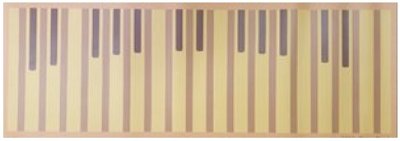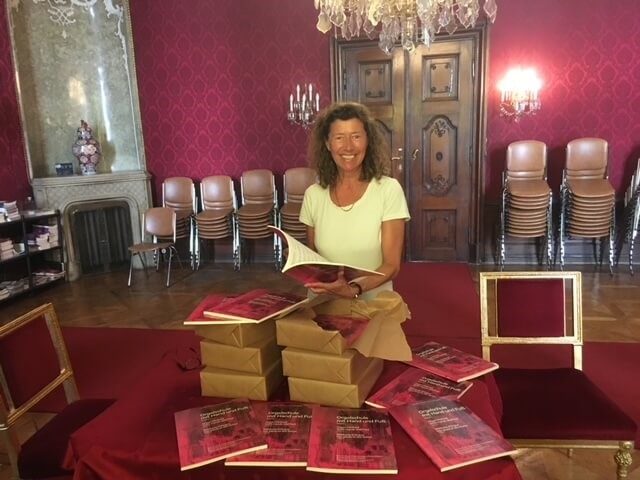World-renowned organist Ulrike Theresia Wegele talks about her popular Orgelschule mit Hand und Fuß, which covers everything you need to know about the entire organ literature in three volumes. Find out how varied and exciting the textbooks are for beginners, returners and autodidacts, why there is no need for unicorns, knights and fairies to inspire children to learn to play the organ, and the very personal motivations that led to her life's work.
I wrote Organ Method With Hands and Feet because I felt there was no suitable textbook available. My organ lessons were characterised by carrying around a multitude of volumes of music, a piece from this volume, a piece from that volume, I wanted to finish. In Organ Method With Hands and Feet, students start on page 1 and work their way through page by page to the end of volume 3.
No other materials are needed as there are always blank lines for notes. This replaces the need for an exercise book, which cannot be forgotten. It was important to me that it should be possible to learn to play the organ without any previous knowledge and without having to play the piano for a few years, and so Volume 1 gives a lot of space to the notation.
Like many organists of my generation, I had to struggle through the long outdated Kaller organ school as a child; the present and following generations are spared this. There are no formative textbooks for me; after completing the first volume of Kaller, I was trained exclusively with literary works, and that was very good. But I am aware that there are different approaches to teaching. That is why it is good that there is now such a wide range of teaching materials and that everyone can choose the one that suits them best.
All disciplines are included from the outset: Music theory, improvisation and the student's own creative work are encouraged through repeated invitations to write small original compositions. The wide range of literature is much appreciated, covering all periods. From the earliest organ pieces from the Robertsbridge Codex around 1330 to contemporary organ works, some written especially for this organ school.
This organ school also works out the different articulations in terms of historical performance practice, and teaches stylistic knowledge and registration skills for French, Italian and Spanish organ music as well. At the end of volume 3, one has the tools to really work out all organ literature.
The complementary playbooks to each volume, Make the Pipes dance!, Pull Out All The Stops! and Pro organo pleno offer such a comprehensive fund of organ literature that learners will have become familiar with all the major composers. Chamber music for each level is also included in the individual volumes to give the possibility of making music together. The final volume, the pedal book All by Foot, contains a really attractive collection of melodies from well-known piano pieces, oratorios, operas and operettas to new pieces from jazz and swing, which all students will enjoy and which will also ensure a mature pedal technique.
The target group is easy to define: this organ school is for everyone who wants to learn to play the organ. It is suitable for children from about eight years of age, but it does not contain any detectives, unicorns, knights or fairies, as was highly praised in the review by üben & musizieren 1/2020.
In my opinion, children can cope well with very clear instructions and do not need distracting pictures in a textbook. My organ school gives all the necessary information and instructions and avoids unnecessary frills, which in my opinion promotes concentration on the essentials. It is therefore suitable for learners of all ages and can also be used autodidactically thanks to the supplementary videos.
We use YouTube to embed video content. This Google service has its own cookies and may collect data about your activity. You can find more information in the data protection declaration of the provider. We need your consent to display YouTube videos:
Show YouTube contentAs a child, I was particularly inspired by Joseph Gabler's organ (built 1737 - 1750) in the Basilica of St. Martin in Weingarten / Württemberg). That's why I recorded my first CD there. The cover of my organ school depicts the prospect of this organ. (You can read more about this and about her wish to work as a teacher in Portrait of Ulrike Wegele)
The inspiration for writing pieces comes from my students and their abilities and preferences. The exercises and pieces I have written for the Organ School with Hands and Feet have purely pedagogical purposes. For example, the Elegy in A Minor was written to teach the basic cadences, and the Pedal Waltz in G Major was written to improve pedal technique in a fun way. The very popular and often performed piece "Pierrot" from the Organ School Volume 1 was also written in 2011, when I could not find a suitable contemporary piece for a youth competition for a pupil at that time.
It certainly differs from other textbooks on the market because of all the above. Personally, I don't like organ books where you have to read pages and pages of introductory texts before you can even play a note, or where you have to jump back and forth in the book, or even worse, within the volumes. Even as a beginner, I would have liked to have had exactly this organ school. There are also organ books that are overloaded with information, and you are overwhelmed by their flashy presentation. The Organ school with Hands and Feet is deliberately kept simple in layout in order to be able to concentrate on the essentials, learning to play the most beautiful instrument there is. The well-known Viennese organist Peter Planyavsky has written about the organ school: "This organ school is exciting! With this initially platitudinous statement I mean to say: one is always curious about the next page, the next step, the next subject." This makes it attractive and varied for the learners.
I designed this organ pedal template together with a master organ builder. I wanted to create a low-threshold possibility so that organists who rarely have the opportunity to practise on an organ can comfortably work out the coordination of hands and feet at home. This thin carpet made of PVC can be comfortably placed under any piano or keyboard, and so even in winter, when it is very cold in the churches, the most necessary can be worked on.

Organ pedal template at Stretta
I see the publication of my Organ Method With Hands and Feet as a logical consequence of my decades of teaching; it is virtually the sum of my work and my pedagogical legacy. The first presentation took place, appropriately enough, at the University of Art in Graz, where I have been teaching for 32 years. It was celebrated in the family circle, because my family has been and still is a great support to me. I dedicated The Organ Method With Hands and Feet to all my students and pupils.
Redakteur: Florian Boberski
Homepage: https://wegele.at/
Ulrike Theresia Wegele is one of the leading organists of her generation. She teaches in Graz and Eisenstadt and lives in Vienna, where she published her popular Orgelschule mit Hand und Fuß with the Doblinger publishing house.
Learn more about Ulrike Wegele - The renowned organist and textbook author in portrait here.

There is a separate Stretta website for the country Worldwide. If your order is to be delivered to this country, you can switch, so that delivery times and shipping conditions are displayed correctly. Your shopping cart and your customer account will remain the same.